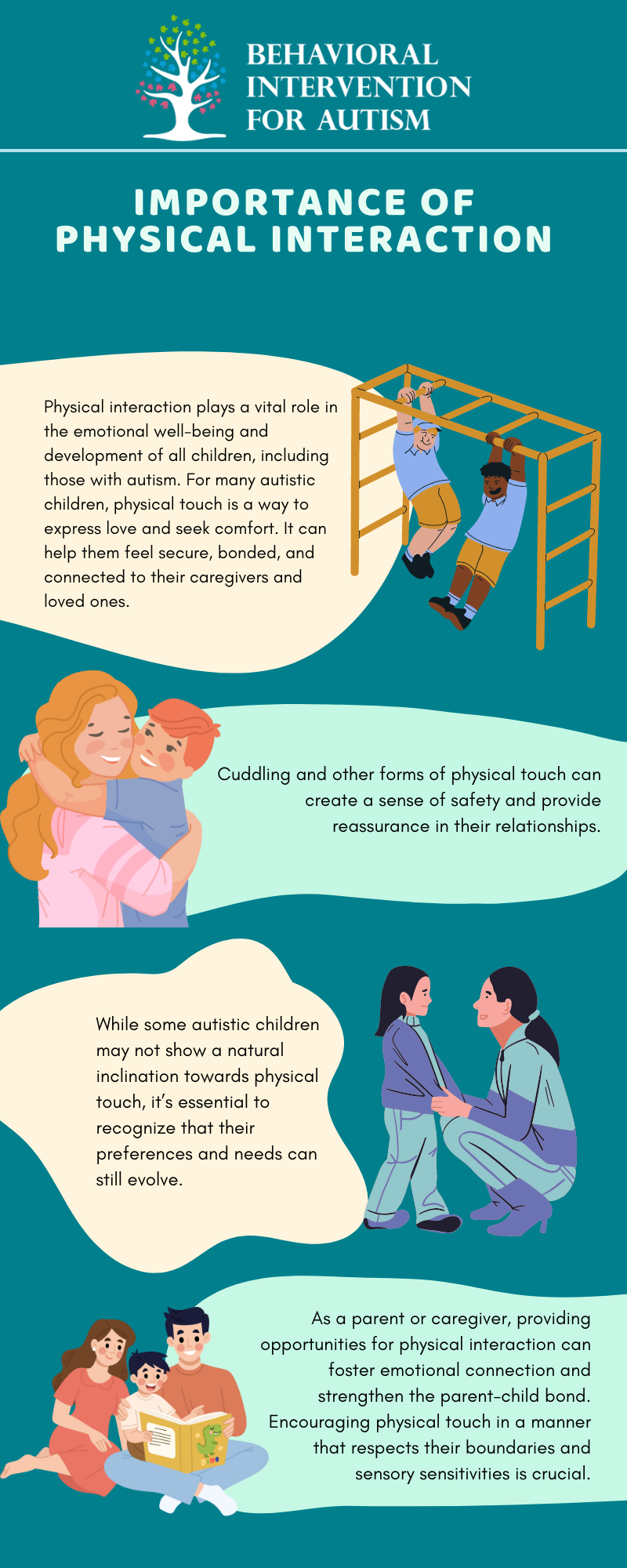
Table of Contents
For some autistic children, expressing love through touch, such as cuddling or hugging, can be a meaningful way to connect with others. Even though they may be touch-resistant due to sensory issues, their desire for physical closeness and affection remains. These children may seek out cuddling as a way to feel secure, show their love, and seek comfort from their caregivers.
However, it’s important to note that not all autistic children enjoy cuddling or hugging, as each individual has unique sensory preferences and sensitivities. Some children may find other forms of touch more comfortable and enjoyable.
Understanding and respecting their boundaries is crucial in fostering a positive and supportive environment.
Alternative Ways of Affection
Autistic children may express their love through alternative forms of affection that suit their sensory needs.
While cuddling and hugging are commonly associated with affection, some children may not find these gestures enjoyable or may find them overwhelming. In such cases, alternative methods can be explored to cater to their individual needs.
Physical games, roughhousing, or engaging in contact sports can provide opportunities for physical contact and incorporate touch into their daily routines. Holding hands is another simple way for autistic children to express love and seek security without requiring as much contact as an embrace. Some children may also enjoy backrubs, back scratches, or hair brushing as a way to receive physical touch and show affection.
By understanding and appreciating the unique ways autistic children express love and seek connection, parents and caregivers can create an environment that supports their individual needs. It is essential to respect their boundaries, communicate openly, and explore various forms of affection that align with their sensory preferences.
Physical Touch and Autism
When it comes to autism, the expression of affection and love through physical touch can vary from person to person.
Some autistic children may exhibit a strong preference for cuddling and physical contact while others may have sensory sensitivities that make them resistant to touch. Understanding the importance of physical interaction and sensory preferences in affection can help parents and caregivers navigate these dynamics with their autistic child.
Sensory Preferences in Affection
Sensory sensitivities are commonly experienced by individuals with autism. These sensitivities can affect how they perceive and respond to physical touch. Some autistic children may find certain types of touch overwhelming or uncomfortable, while others may seek out specific sensory input.
Hence, it’s important to be mindful of their sensory preferences and respect their boundaries when engaging in physical touch. It’s essential to observe and understand your child’s individual sensory preferences when it comes to physical touch.
Keep in mind that each child is unique, and it’s crucial to adapt to their individual needs and preferences while fostering emotional connection through physical touch.
Overly Affectionate Behavior
Sometimes, parents may notice that their autistic child displays overly affectionate behavior, such as excessive cuddling or a desire to be physically close to others. Understanding the causes of clingy behavior and teaching boundaries and social norms are important aspects of supporting children with autism.
Causes of Clingy Behavior
Clingy behavior in children with autism can stem from various factors. Some children with autism may have attachment disorders or difficulties which can contribute to their desire for constant physical contact.
Additionally, autistic children may seek sensory stimulation through deep-pressure hugs, which provide comfort. They may also use light touch or sensory tools on pressure points to fulfill their need for sensory input.
It’s important to recognize that every child is unique, and the reasons behind clingy behavior may differ. Some children may struggle with understanding social norms and appropriate boundaries. This can lead to behavior such as not minding personal space, wanting to be overly touchy, or wanting to kiss and hug strangers.
Teaching Boundaries and Social Norms
Helping an overly affectionate autistic child understand boundaries and social norms is crucial for their development. By teaching alternative ways to engage, parents and caregivers can help children express affection while respecting personal space.
One approach is to provide clear and consistent guidance about appropriate physical contact. Children can be taught to ask for a high-five or blow a kiss instead of hugging or kissing. Reinforcing the concept of personal space and explaining when it is appropriate to touch or hug others can also be helpful.
Using social stories and role-playing can be effective tools for teaching boundaries and social norms. Social stories provide visual representations and narratives that help children understand different social situations and appropriate behavior. Meanwhile, role-playing allows children to practice social interactions in a safe and controlled environment. It also helps them develop the skills needed to navigate social relationships.
By actively teaching and reinforcing boundaries and social norms, parents and caregivers can support their autistic child in developing appropriate social skills while still allowing for meaningful connections and expressions of affection.
Supporting Your Autistic Child
As a parent or caregiver of an autistic child, it’s important to provide the necessary support to help them navigate social interactions and manage their sensory needs. By understanding their unique challenges and implementing strategies, you can create an environment that promotes their overall well-being.
Understanding and embracing alternative methods, along with practicing social scenarios through role-playing, can greatly support both the emotional well-being and social development of a child with autism.
By tailoring parenting strategies to the unique needs of their child, parents can create a nurturing and inclusive environment for their autistic child to thrive.
Sources:
https://www.autismparentingmagazine.com/overly-affectionate-autistic-child
https://springbrookbehavioral.com/physical-touch-for-kids-with-autism-a-basic-human-need
- Florida Senate Backs Autism Support Bill for Families - February 19, 2025
- Key Questions to Ask an ABA Provider Before Enrolling in Florida - February 19, 2025
- 8 Essential Autism-Friendly Travel Tips for a Stress-Free Trip - February 18, 2025



